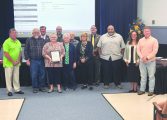Sheridan to serve as vice-chair
By Heather Michon
Correspondent
Early January is a great time to get organized for the new year, and that’s exactly what the Board of Supervisors did on Wednesday night (Jan. 3).
As they do each first meeting of the year, the first order of business was to elect new leadership.
In his first act as Palmyra’s supervisor, Tim Hodge nominated Chris Fairchild (Cunningham) as chair. Fairchild was elected 4-0.
Tony O’Brien (Rivanna) then nominated former chair Mike Sheridan (Columbia) to serve as vice-chair. Again, the vote was 4-0.
After some discussion, supervisors decided to make a slight modification to the schedule.
For many years, the board has met on the first and third Wednesdays of the month, alternating start times between 5 p.m. and 7 p.m.
Hodge suggested changing the start of the second meeting of the month from 7 p.m. to 6 p.m. He argued that this was a better time for the public who might want to attend and “would mean we have a better chance of getting out of here at a more reasonable hour.”
They also discussed holding public hearings promptly at 7 p.m., even if it meant temporarily suspending discussion on an agenda item.
County Attorney Dan Whitten said the supervisors could make any changes to the schedule at any time, provided the public was notified in advance.
Commissions and committee assignments came next. New Fork Union supervisor Mike Goad was appointed as board representative to the Planning Commission, where he recently served as Fork Union commissioner.
Later in the meeting, Kathleen Kilpatrick was appointed to his seat on the commission.
Route 250 water line
After the organizational meeting, supervisors turned to the regular agenda. Here, there was only one item up for discussion: the extension of the Zion Crossroads water line.
In early 2020, the Virginia Department of Environmental Quality (DEQ) asked the county to extend the new water line past its planned terminus at Memory Lane and Route 250 by 1.1 miles west, where a petroleum leak from the former Beaver Dam Market gas station had resulted in groundwater contamination to about five homes in the vicinity.
DEQ offered $1.5 million towards the construction of the extension. This was seen as a win-win for all involved; it would help the state bring a safe and reliable water source to the impacted homes, and it provided Fluvanna with a low-cost way to support commercial and residential growth down the 250 corridor.
To move forward, supervisors needed to pass a motion to approve the extension, and then select a funding source from a range of options ranging from grants to loans to the county’s unassigned fund balance.
County Administrator Eric Dahl said the cost of the construction had more than doubled in the two years since the project was first proposed and was now estimated at around $3.8 million. The DEQ would pay the original $1.5 million offered, but the county’s share was increased to around $2 million.
The new members expressed some skepticism about the project, with Hodge, in particular, wondering if there would be enough business growth in that section of 250 to justify the expense.
Fairchild added that the extension didn’t seem to have been on the table until the state had approached the county, and “if this board wasn’t thinking about [the extension] at $1.5 million, why are we thinking about it at $2.2 million?”
He said taking out debt service on a line extension that may not be developed for a decade or more was saddling the taxpayers with “generational” debt.
Sheridan countered that they had envisioned extending the project all the way to the county line from the beginning of the water project, but it was seen as too costly until the DEQ came forward with the offer.
O’Brien argued that a $2 million project was a drop in the bucket considering the $20 million or so the county was investing in building out its water and wastewater infrastructure.
He suggested deferring the matter until the new members could be brought up to speed on the project.
This was the eventual conclusion of the discussion, with members voting 5-0 to defer any decision until the July meeting.




